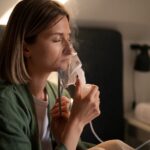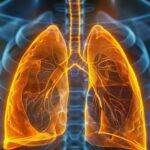Bronchoscopy
What is “Bronchoscopy”?
A bronchoscopy is a procedure that allows your pulmonologist doctor to look at the trachea (windpipe), the bronchi (branches of the airways) and into some areas of the lungs through a thin, long, tube, about the width of a pen called a bronchoscope. The tip of the endoscope has a small camera with light source, which transmits the image to a video monitor. During the bronchoscopy test, a bronchoscope is passed up through your nose or mouth, past your larynx (voice box) down your trachea and into the bronchi.
The doctor will take some samples of any mucus or other secretions found in the airways for laboratories for analysis. Sometimes it is required to take a biopsy (small piece of tissue) of lung (TBLB) or airways (EBB) or needle aspiration of glands in chest (TBNA) which is sent to the laboratory for analysis. This is done by passing small instruments called forceps or needle through the bronchoscope.
There are two types of bronchoscopes: flexible and rigid bronchoscopy. Flexible bronchoscopy done with a flexible pipe, is the most common type of bronchoscopy, as it allows for a more detailed examination of the airways with less discomfort and risk than rigid bronchoscopy. Rigid bronchoscopy is done with rigid metal pipe in especially when a complex therapeutic intervention is planned.
Why is it done? (Indications for Bronchoscopy)
Bronchoscopy can be a diagnostic and therapeutic procedure. This procedure is called diagnostic when it used to help us to check (diagnose) whether or not any disease is present in your respiratory (breathing) system such as lung cancer, infections, inflammation, or bleeding (hemoptysis). This procedure is called therapeutic when the pulmonologist doctor intervenes in the airways with an intent to treat e.g, foreign body, mucus plugs extraction, or removing any central airway obstruction due to cancer or putting an airway stent.
How to prepare for the Bronchoscopy test?
Before your appointment
- You should remind the medical staff looking after you if you have bleeding problems or take blood-thinning medicine, such as aspirin/clopidogrel/ warfarin, as their dose may need to be adjusted
- You should remind the medical staff looking after you if you are taking any medicines, especially for hypertension or diabetes (insulin)
- You should tell your doctors if you are allergic to any medicines, including anesthetic.
On the day
- You will be asked not to eat or drink for four to six hours before your appointment
- All your regular medications will be given as normal with a little water
- You will be bought to the Endoscopy suite, which is at the ground floor of Max Super Speciality Hospital (West Block)
- When you arrive in the department there may be a delay before your procedure so bring something to read or do to help pass the time
What is the Procedure of Bronchoscopy? How is Bronchoscopy done?
- In the examination room you will be made comfortable on bed in semi-errect or lying down position
- A nurse will place a cannula into a vein on your hand/ arm so as to give a sleeping injection to make you feel sleepy and relaxed. You may remember a little about what happened but often you will remember nothing
- A local anaesthetic will be sprayed into your mouth to the back of your throat. This numbs your throat.
- Local anaesthetic jelly is inserted into your nostrils; this makes it more pleasant to have the tube in your nose.
- As the bronchoscope is passed through your nose, some more local anaesthetic to numb the larynx (voice box) is given. This may make you cough a little. As the local anaesthetic takes effect, your throat will relax.
- You may be given extra oxygen by putting a soft plastic tube just inside your nostril. A plastic ‘peg’ will be placed on your finger to monitor your pulse and oxygen levels
- The doctor may also insert sterile normal saline, tiny instruments (forceps, needle) through the bronchoscope to collect samples and do biopsy. The biopsy (TBLB, EBB) and TBNA test is completely painless
- The bronchoscopy usually takes fifteen to twenty minutes, but it may take longer, depending upon what is found and what is done during the test
- Some patients may be given a sedative or general anesthesia to minimize discomfort and help them relax.
What happens after the Bronchoscopy?
- After the bronchoscopy you might have a slight nosebleed. If some biopsies have been taken, you might find some streaks of blood in your phlegm. This is quite normal and will usually stop within 24 hours.
- If you have any soreness in the throat or a hoarse voice, this is quite normal and usually gets better within a day or so.
- Eating and drinking: If your throat was numbed before the test, you will be advised not to eat or drink for about two hours after the bronchoscopy, because your throat will still be numb. It is not safe to eat or drink until full sensation has returned.
- After the bronchoscopy, you will be taken to a recovery area while the sedation wears off. When you are sufficiently awake, you will be sent to the ward, this may be up to an hour following the examination
- If you are discharged from hospital within 24 hours of your procedure you are advised not to drive, operate machinery, return to work, drink alcohol or sign any legally binding documents. You are also advised to have a responsible adult stay with you for the next 12 hours.
- Check-ups and results: If no biopsy is done doctor will be able to tell you your result immediately after the bronchoscopy as soon as you are awake from sedation. If a biopsy is taken, doctor won’t be able to give you a final opinion for a few days until the tissue has been processed in our laboratories.
- You should inform the medical staff, if you have excessive bleeding with cough, difficulty breathing or chest pain or any complications after the bronchoscopy procedure.
What are the risks & complication of bronchoscopy?
- Having a bronchoscopy is a relatively safe procedure. The chance of having a complication is small. Vast majority of patients have an uneventful procedure and recovery. Complications are extremely rare and not all the ones listed below are applicable to one individual.
- Occasionally, major bleeding (less than 1 in 1000) can occur from the biopsied area which may require further stay in hospital for observation.
- If you have had a lung biopsy, there is a small risk of leakage of air from the lung (Pneumothorax/collapsed lung).
- Patients who need to have this type of biopsy may stay in hospital for monitoring and have a chest X-ray. In a small proportion of these patients, we might need to insert a chest drain (a tube) to remove the unwanted air in the chest.
- Side effects of sedation include effects on heart rate, blood pressure and oxygen saturation in blood. All these parameters are constantly monitored throughout the bronchoscopy procedure. Appropriate measures will be taken immediately, if any abnormality arises.
- Other minor side effects include sore throat or hoarseness and rarely infection and breathing difficulties, allergic reactions to medications used during the bronchoscopy procedure
If you have any concerns about your lung health or are experiencing respiratory symptoms, talk to your lung doctor about whether a bronchoscopy may be appropriate procedure for you or not.
What is the Bronchoscopy test price?
The bronchoscopy test price varies based on depending upon type bronchoscopy procedure, whether it is diagnostic procedure or therapeutic procedure. Bronchoscopy test price also varies from various places in India. In Delhi NCR itself Bronchoscopy cost is different with different bronchoscopy test prize range. Usually a basic diagnostic Fiberoptic Bronchoscopy procedure (including Bronchoalveolar Lavage, BAL) cost ranges from Rs10000 to 20000, but in case a biopsy, conventional transbronchial needle aspiration (TBNA) is done then the bronchoscopy test price, cost increases and can go upto Rs 50,000.
FAQ
A bronchoscopy allows medical professionals to examine your airways and lungs. Typically, a pulmonologist—a medical professional who specializes in lung disorders—performs it. A little tube called a bronchoscope is inserted into your mouth or nose, down your throat, and into your lungs during a bronchoscopy.
A bronchoscopy test's price might change based on a number of variables, including the hospital, the region, the cause for the procedure, and whether any more tests or treatments are carried out while the bronchoscopy is being done. A bronchoscopy in India, will cost anything from INR 10,000 to INR 20,000 or more.
A medical practitioner performs a bronchoscopy by inserting a thin, flexible tube into the patient's lungs through the nose or mouth. A light and a tiny camera allow the doctor to see and examine inside the airways of the lungs. To help the patient feel more comfortable, sedatives or anesthesia are often administered before a bronchoscopy.
Despite being a generally safe technique, bronchoscopy carries some hazards, such as bleeding, infection, anesthetic or medication-related allergic reactions, and airway perforation. Although uncommon, serious consequences can occur.
A bronchoscopy procedure's time can vary based on its intended use and whether further procedures are carried out. The process usually takes half an hour to an hour to finish on average.
Because patients are routinely given sedation or anesthetic to keep them comfortable during the procedure, bronchoscopies are generally not uncomfortable. Following the procedure, some patients could have moderate discomfort or sore throats.
Numerous lung disorders, such as infections caused by bacteria, viruses, fungus, parasites, or tuberculosis, can be diagnosed by your doctor with the aid of a bronchoscopy. In addition, it can be used to diagnose lung cancer and other lung disorders as well as identify inflammation in the lungs caused by allergic reactions.
The night before the bronchoscopy, you will not be allowed to eat or drink anything. Your doctor might let you take some of your prescriptions, though. Please make sure that, before the procedure, you consult your physician how to handle your daily prescriptions.
Yes, bronchoscopies are frequently done as outpatient procedures, allowing patients to return home the same day. But if sedation or anesthesia was administered during the treatment, they could require a companion to drive them home.
Results from a bronchoscopy can take a while to come in, depending on the tests carried out and the policies of the hospital. Preliminary results can sometimes be obtained right away following the surgery, although tissue sample results might take a few days to a week or longer to complete. You and your doctor will talk about when to expect results.



